

A visit to “Garton & King’s High Street Emporium” on the High Street Shop page will give you a taster of the huge range of products available, but here are examples of some that have survived to the present day or are out there ‘somewhere’.
On a summer weekend in suburbia those fortunate (some would say unfortunate) to have a lawn might be striving to achieve that goal that always seems to be just out of reach – the pinstripe weed free bowling green effect level lawn. Nowadays that activity would be accompanied by a cacophony of sound from petrol and electric powered grass cutters and strimmers but before the Great War it is likely, if you had the Excelsior Mower shown below, you also had the servants to operate it or a convenient Pony to pull you around if you could afford the ‘sit on’ model.
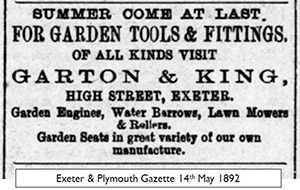 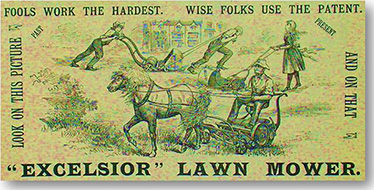 |
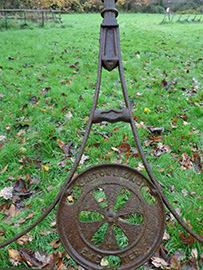 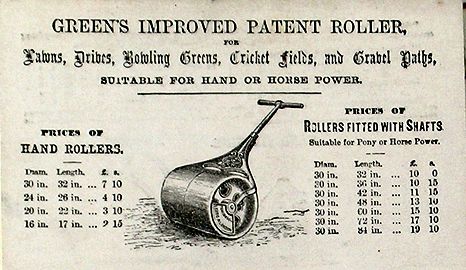 |
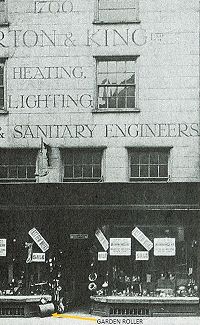 On the ‘Not What They Appear to Be’ page the topic of Badge Engineering was broached and a variety of municipal castings were shown that could well have been made by the Company. Turning the subject around to the Company adding their name to products that they did not make, a fine example is the Garden Roller! Flaunting the Company Name could well get the product noticed as this tale (posted on the 1st January 2025) tells.
On the ‘Not What They Appear to Be’ page the topic of Badge Engineering was broached and a variety of municipal castings were shown that could well have been made by the Company. Turning the subject around to the Company adding their name to products that they did not make, a fine example is the Garden Roller! Flaunting the Company Name could well get the product noticed as this tale (posted on the 1st January 2025) tells.
When this page was first posted (?) the best I could come up with was the image of a roller sent in by a friend. Badged with the Garton & King, Exeter name (dating it pre 1924). A standard 18” diameter roller by Warners in the 1900 catalogue was offered for £2.10. 0d – two pound ten shillings (£2.50) and the sharp eyed amongst you readers will have noticed that, prior to the closure of the Garton & King’s Ironmongery Shop at 190 High Street a garden roller was positioned to the left of the shop entrance (see enlargement).
A few days ago I was told about a Garden Roller with the G & K Badge being offered for sale in an Auction to be held by a very long established Exeter Firm of Auctioneers – needless to say I am now the owner – I haven’t got a lawn admittedly but Garton & King Badge Engineered products don’t turn up every day of the week! This one is at least 90, possibly 100 years old, being badged by G & K sometime after they became a Limited Company in 1924 and prior to the closure of the Ironmongers Shop in 1933 – maybe it’s the one pictured here in front of the shop!
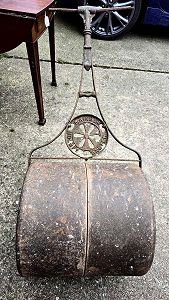 |
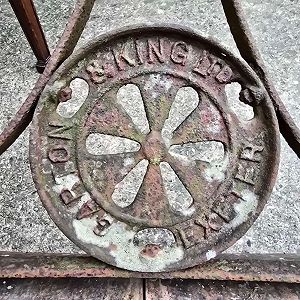 |
After all this strenuous activity, especially having pulled a roller up and down your lawn, you may feel that such effort might cause a hernia and on these grounds you’d be justified in giving up the struggle! Sorry to disappoint you but a recent report on a reputable website stated “We conclude that we are unable to find any clinical evidence to support the hypothesis that a hernia might develop as the result of one single strenuous or traumatic event” So that garden roller, already perhaps a survivor from the 20th Century, is there for the future. Your push mower however, may well have been dumped at the local Recycling Centre but a few manage to hide away, relegated to an inaccessible corner of the shed awaiting re-discovery. Some may even have been set aside as a ‘sometime in the future’ Restoration Project.
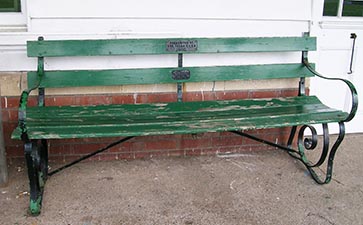 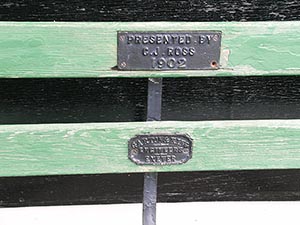 |
Whatever gardening activity you indulge in, there are still proud owners out there with their Garton & King Garden Seats. The two images above are of the green painted seats that were, and hopefully still are, at the Exeter Cricket Club (founded 1824) on Prince of Wales Road in Exeter. The first of the small images below is of a privately owned seat still bearing its nameplate, the other 2 images relate to a pair of seats at the Church of Our Lady at Upton Pyne, so if you still have one then take the weight off your feet and have a sit down!
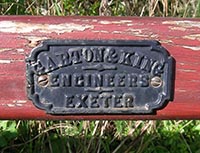 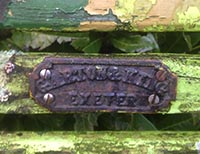 |
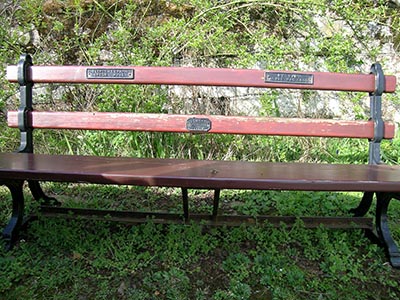 |
Should your leisure time activity extend to horse riding then it may surprise you to know that artefacts that were once listed in G & K’s Catalogues of Stable Fixtures and Fittings are still out and about amongst the stables and tack rooms of the equine fraternity. Whilst some of the facilities once enjoyed by the larger estates (Lord Portsmouth’s Eggesford Estate is just one) are almost no more, there’s a pair of brackets from his stables shown here.
Certain owners such as Boldtry Stables near South Molton are still utilising brackets and other items that once graced the pages of the Stable Fixture Catalogue, including other bracketry and even the Stable Stall Divisions. See the Saltram House page.
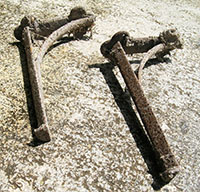 |
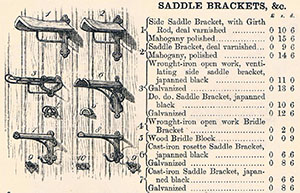 |
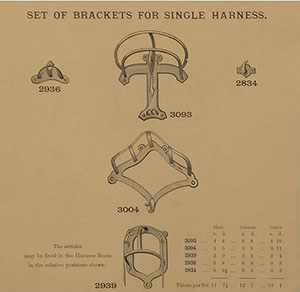 |
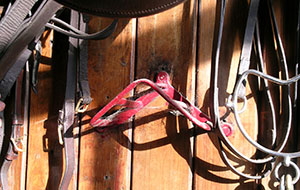 |
In addition to the products the Company made they also retailed other Manufacturers’ popular items and were appointed ‘Agents’ indeed sometimes even ‘Special Agents’ – perhaps with a licence to thrill! Garton & King and subsequently Garton King Appliances held appointments as Agents for such well known manufacturers as BENDIX, AGA, MIELE and RAYBURN. Up until 1933, when the High Street Ironmongers shop closed after some 270 years of trading, the Company had been appointed Agents at varying times for a variety of devices, products, Manufacturers and Services. This compilation barely skims the surface.
 One device that had a period of popularity in the early part of the 20th Century amongst owners of country churches, mansions, vicarages etc (especially those well away from the piped Gas supply) was that of the Petrol Gas Generator. The advert shows that G & K were promoting this method of creating Gas from Petrol. An Express & Echo Advert dated 29 January 1910 stated “See Plant working at Agents for Devon, Garton & King.” The brochure in our archives, states that the two systems operated under the Patents of Monsieur De Laitte and Mr Elwell–Smith had merged and were now operating as Safety-Light Limited and Garton & King were, in January 1911 appointed Agents.
One device that had a period of popularity in the early part of the 20th Century amongst owners of country churches, mansions, vicarages etc (especially those well away from the piped Gas supply) was that of the Petrol Gas Generator. The advert shows that G & K were promoting this method of creating Gas from Petrol. An Express & Echo Advert dated 29 January 1910 stated “See Plant working at Agents for Devon, Garton & King.” The brochure in our archives, states that the two systems operated under the Patents of Monsieur De Laitte and Mr Elwell–Smith had merged and were now operating as Safety-Light Limited and Garton & King were, in January 1911 appointed Agents.
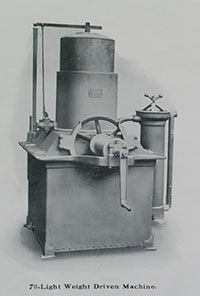
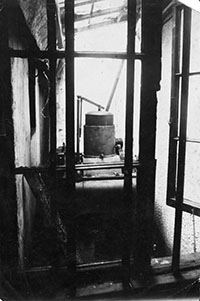 Strange as it might seem there is an image that has been in a box of photos in the archives for years. Every time I see it I end up having to put it back in the box, not having a clue what or where the image was taken or what the device was. Quite recently I looked again at the image you see here and with the help of my brother we solved the mystery. Not only did we identify the apparatus as a Weight Driven Petrol Gas Machine but we were also able to identify its location at the Waterbeer Street Foundry. The first black & white image on the Waterbeer Street Foundry page confirms that the machine was located behind the small cupola in an area behind the brickwork. I have read the Brochure a few times but still cannot quite understand how it worked so you’ll have to Google it!! I should point out that petrol back then was about 1/3d a gallon (6p – 7p) and the Brochure lists the selling points of the system:-
Strange as it might seem there is an image that has been in a box of photos in the archives for years. Every time I see it I end up having to put it back in the box, not having a clue what or where the image was taken or what the device was. Quite recently I looked again at the image you see here and with the help of my brother we solved the mystery. Not only did we identify the apparatus as a Weight Driven Petrol Gas Machine but we were also able to identify its location at the Waterbeer Street Foundry. The first black & white image on the Waterbeer Street Foundry page confirms that the machine was located behind the small cupola in an area behind the brickwork. I have read the Brochure a few times but still cannot quite understand how it worked so you’ll have to Google it!! I should point out that petrol back then was about 1/3d a gallon (6p – 7p) and the Brochure lists the selling points of the system:-
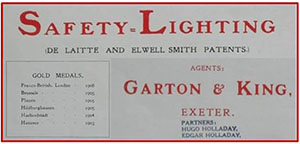 Utilise for Heating or Lighting
Utilise for Heating or Lighting
No danger of explosion. No unpleasant smell
No smoke or sooty ceilings. A pleasant light
Self starting & self stopping mechanism
Constant pressure and an unvarying quality of gas
No condensation in pipes, Minimal cleaning
No refuse to remove, No waste when idle
Weight Driven Machines for installations of between
15 lights (£26 10s 0d) & up to 115 lights, £150
There can be no doubt that the Petrol Gas created by the machine was used by the company, probably for lighting, and the installation, being in operation, served as a promotional tool for potential customers. If you have any G & K relics in your shed contact me!
Updated January 2025
Top of Page
See also:
High Street — The Little Bit Unusual — Illumination
Saltram House — Oddities, Stories and Trivia
Sitemap / Contents